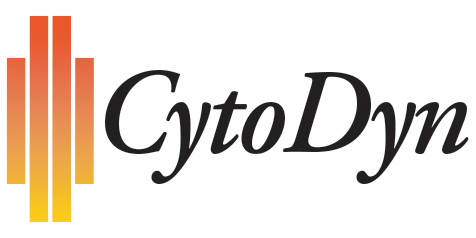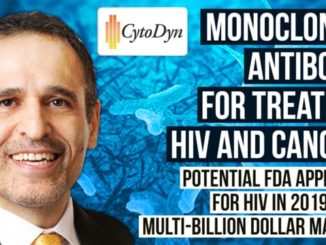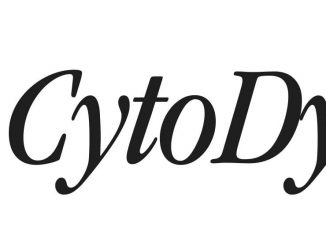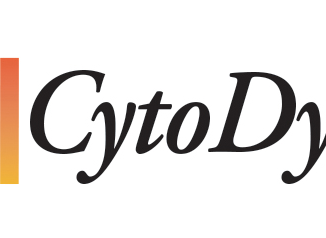
New preclinical data using a humanized mouse model confirms and expands on the potential use of leronlimab in treating this inflammatory syndrome, a common precursor to NASH
VANCOUVER, Washington, Nov 21, 2019 — CytoDyn Inc. (otc.qb:CYDY), (“CytoDyn” or the “Company”), a late-stage biotechnology company developing leronlimab (PRO 140), a CCR5 antagonist with the potential for multiple therapeutic indications, today announced strong positive preclinical data highlighting the potential of leronlimab in treating nonalcoholic fatty liver disease (NAFLD), a common precursor to nonalcoholic steatohepatitis (NASH). These data, along with previous findings showing that leronlimab inhibits liver fibrosis, demonstrates the potential of leronlimab to control both the early and late stages of NASH.
The study, in which immunodeficient, NOD-scid gamma (NSG) mice were fed a high fat, NASH-inducing diet, transplanted with human stem cells to repopulate the deficient immune system, and treated with leronlimab, found that that leronlimab effectively inhibited fatty liver development, an early indication of NASH. CytoDyn previously published data showing that leronlimab completely blocked Xeno-GvHD in these humanized mice. Daniel Lindner, M.D., Ph.D. of the Cleveland Clinic, who conducted the studies, stated: “Our results showed that leronlimab effectively inhibited fatty liver development, the hallmark of early stages of NASH.”
“We are very excited to see more evidence showing that leronlimab may play a critical role in slowing or reversing disease progression in NAFLD and potentially NASH patients,” said Nader Pourhassan, Ph.D., CytoDyn President and Chief Executive Officer. “It is important to note that in people living with HIV, the occurrence of NAFLD is higher than in the general population, affecting 30 to 65 percent of the HIV population [1] . Medications that HIV patients take as part of their regimen may cause fatty liver development and have other hepatoxic effects. As we approach 1,000 patients involved in our HIV trials, we have not observed the hepatoxicity that has been evident in other CCR5 antagonists and HIV medications. We see leronlimab as potentially anchoring a patient’s HIV treatment regimen, or as a monotherapy HIV drug, designed to protect the liver, maintain and regain liver health, and protect healthy cells from HIV entry.”
There are currently no U.S. Food and Drug Administration (FDA) approved treatments for NASH and it is expected to be the number one cause of liver transplant by 2020 [2] . About 30 to 40 percent of adults in the U.S. are living with NAFLD, and 3 to 12 percent of adults in the U.S. are living with NASH [3] .
“The significant unmet medical need and the lack of approved treatment options for NASH has led to a healthy interest in licensing therapeutics, even those in the preclinical phase,” said Brendan Rae, Ph.D., J.D., CytoDyn Senior Vice President of Business Development. “Based on recent activity in the space, combined with leronlimab’s efficacy and human safety profile in the model, we expect there to be a significant interest from industry stakeholders in the development of leronlimab for the treatment of NASH.”
CytoDyn has an FDA approved Phase 2 protocol for a 60-patient, multi-center, randomized, double-blind, placebo-controlled study of the safety and efficacy of leronlimab (PRO 140) in adult patients with NASH.
About Nonalcoholic Steatohepatitis (NASH)
Nonalcoholic steatohepatitis (NASH) is a chronic liver disease characterized histologically by the presence of hepatic inflammation and cell injury (hepatocellular ballooning) due to hepatic fat accumulation (steatosis) equal or superior to 5 percent of hepatocytes. Unhealthy eating habits and lack of physical activity in the absence of excessive alcohol consumption contributes to the development of NASH. NASH can progress to high�?�burden conditions such as cirrhosis, end-stage liver disease, and hepatocellular carcinoma (HCC). NASH is expected to become the leading cause of liver transplantation by 2020 in the United States [4] . NALFD is the most common form of chronic liver disease, affecting about 30 to 40 percent of the population in the United States [5] . An estimated 3 to 12 percent of the adult population in the United States have NASH [6] , of which approximately 15 to 20 percent will likely progress to advanced fibrosis or cirrhosis [7] . Despite its very high burden, there are currently no approved pharmacological therapies for NASH. Available therapies focus solely on treating NASH comorbidities, such as obesity, type 2 diabetes mellitus (T2DM) and cardiovascular disease (CVD), while NASH management options focus on lifestyle changes, based on diet and exercise, and control of the associated comorbidities. Lifestyle changes have demonstrated the greatest benefit in improving steatosis and mild fibrosis; however, as patients with advanced fibrosis due to NASH are at a significantly higher risk of liver�?�related mortality, pharmacological treatments are urgently needed [8] .
About Leronlimab (PRO 140)
The U.S. Food and Drug Administration (FDA) has granted a “Fast Track” designation to CytoDyn for two potential indications of leronlimab for deadly diseases. The first as a combination therapy with HAART for HIV-infected patients, and the second is for metastatic triple-negative breast cancer (mTNBC). Leronlimab is an investigational humanized IgG4 mAb that blocks CCR5, a cellular receptor that is important in HIV infection, tumor metastases, and other diseases, including NASH. Leronlimab has successfully completed nine clinical trials in over 800 people, including meeting its primary endpoints in a pivotal Phase 3 trial (leronlimab in combination with standard anti-retroviral therapies in HIV-infected treatment-experienced patients).
In the setting of HIV/AIDS, leronlimab is a viral-entry inhibitor; it masks CCR5, thus protecting healthy T cells from viral infection by blocking the predominant HIV (R5) subtype from entering those cells. Leronlimab has been the subject of nine clinical trials, each of which demonstrated that leronlimab can significantly reduce or control HIV viral load in humans. The leronlimab antibody appears to be a powerful antiviral agent leading to potentially fewer side effects and less frequent dosing requirements compared with daily drug therapies currently in use.
In the setting of cancer, research has shown that CCR5 plays an important role in tumor invasion and metastasis. Increased CCR5 expression is an indicator of disease status in several cancers. Published studies have shown that blocking CCR5 can reduce tumor metastases in laboratory and animal models of aggressive breast and prostate cancer. Leronlimab reduced human breast cancer metastasis by more than 98 percent in a murine xenograft model. CytoDyn is, therefore, conducting a Phase 2 human clinical trial in metastatic triple-negative breast cancer and was granted Fast Track designation in May 2019. Additional research is being conducted with leronlimab in the setting of cancer and NASH with plans to conduct additional clinical studies when appropriate.
The CCR5 receptor appears to play a central role in modulating immune cell trafficking to sites of inflammation and may be important in the development of acute graft-versus-host disease (GvHD) and other inflammatory conditions. Clinical studies by others further support the concept that blocking CCR5 using a chemical inhibitor can reduce the clinical impact of acute GvHD without significantly affecting the engraftment of transplanted bone marrow stem cells. CytoDyn is currently conducting a Phase 2 clinical study with leronlimab to further support the concept that the CCR5 receptor on engrafted cells is critical for the development of acute GvHD and that blocking this receptor from recognizing certain immune signaling molecules is a viable approach to mitigating acute GvHD. The FDA has granted “orphan drug” designation to leronlimab for the prevention of graft-versus-host disease (GvHD).
About CytoDyn
CytoDyn is a biotechnology company developing innovative treatments for multiple therapeutic indications based on leronlimab, a novel humanized monoclonal antibody targeting the CCR5 receptor. CCR5 appears to play a key role in the ability of HIV to enter and infect healthy T-cells. The CCR5 receptor also appears to be implicated in tumor metastasis and immune-mediated illnesses, such as graft-vs-host disease (GvHD) and NASH. CytoDyn has successfully completed a Phase 3 pivotal trial with leronlimab in combination with standard anti-retroviral therapies in HIV-infected treatment-experienced patients. CytoDyn plans to seek FDA approval for leronlimab in combination therapy and plans to complete the filing of a Biologics License Application (BLA) in 2019 for that indication. CytoDyn is also conducting a Phase 3 investigative trial with leronlimab (PRO 140) as a once-weekly monotherapy for HIV-infected patients and, plans to initiate a registration-directed study of leronlimab monotherapy indication, which if successful, could support a label extension. Clinical results to date from multiple trials have shown that leronlimab (PRO 140) can significantly reduce viral burden in people infected with HIV with no reported drug-related serious adverse events (SAEs). Moreover, results from a Phase 2b clinical trial demonstrated that leronlimab monotherapy can prevent viral escape in HIV-infected patients, with some patients on leronlimab monotherapy remaining virally suppressed for more than four years. CytoDyn is also conducting a Phase 2 trial to evaluate leronlimab for the prevention of GvHD and has received clearance to initiate a clinical trial with leronlimab in metastatic triple-negative breast cancer. More information is at www.cytodyn.com.
Forward-Looking Statements
This press release contains certain forward-looking statements that involve risks, uncertainties, and assumptions that are difficult to predict. Words and expressions reflecting optimism, satisfaction or disappointment with current prospects, as well as words such as “believes,” “hopes,” “intends,” “estimates,” “expects,” “projects,” “plans,” “anticipates” and variations thereof, or the use of future tense, identify forward-looking statements, but their absence does not mean that a statement is not forward-looking. The Company’s forward-looking statements are not guarantees of performance, and actual results could vary materially from those contained in or expressed by such statements due to risks and uncertainties including: (i) the sufficiency of the Company’s cash position, (ii) the Company’s ability to raise additional capital to fund its operations, (iii) the Company’s ability to meet its debt obligations, if any, (iv) the Company’s ability to enter into partnership or licensing arrangements with third parties, (v) the Company’s ability to identify patients to enroll in its clinical trials in a timely fashion, (vi) the Company’s ability to achieve approval of a marketable product, (vii) the design, implementation and conduct of the Company’s clinical trials, (viii) the results of the Company’s clinical trials, including the possibility of unfavorable clinical trial results, (ix) the market for, and marketability of, any product that is approved, (x) the existence or development of vaccines, drugs, or other treatments that are viewed by medical professionals or patients as superior to the Company’s products, (xi) regulatory initiatives, compliance with governmental regulations and the regulatory approval process, (xii) general economic and business conditions, (xiii) changes in foreign, political, and social conditions, and (xiv) various other matters, many of which are beyond the Company’s control. The Company urges investors to consider specifically the various risk factors identified in its most recent Form 10-K, and any risk factors or cautionary statements included in any subsequent Form 10-Q or Form 8-K, filed with the Securities and Exchange Commission. Except as required by law, the Company does not undertake any responsibility to update any forward-looking statements to take into account events or circumstances that occur after the date of this press release.



